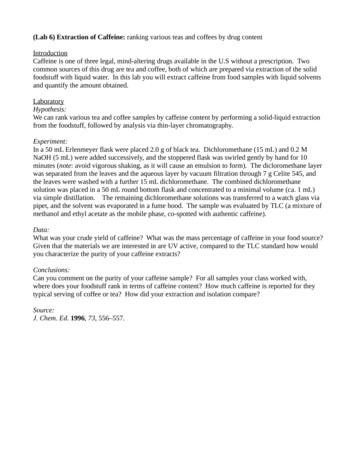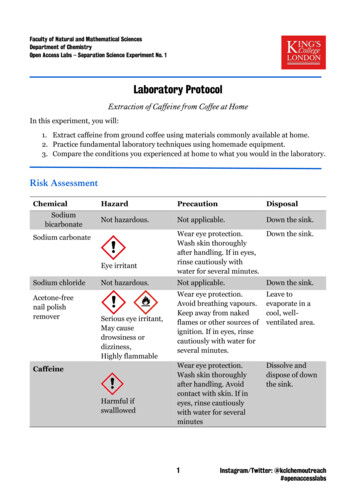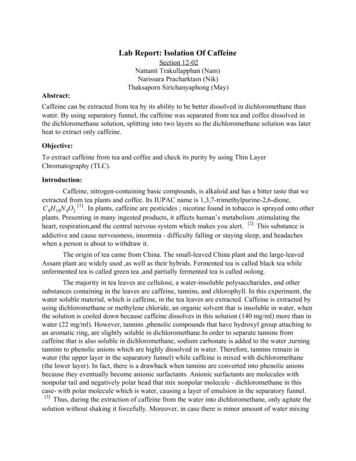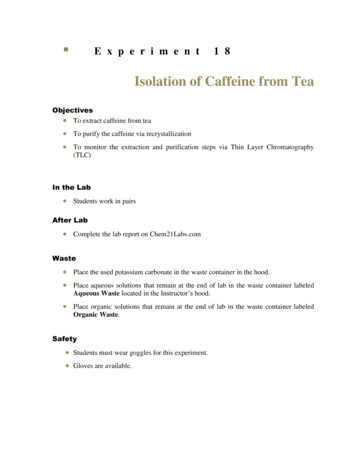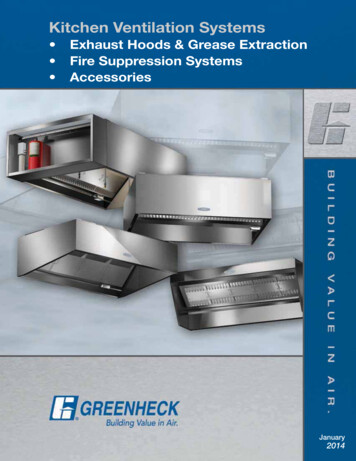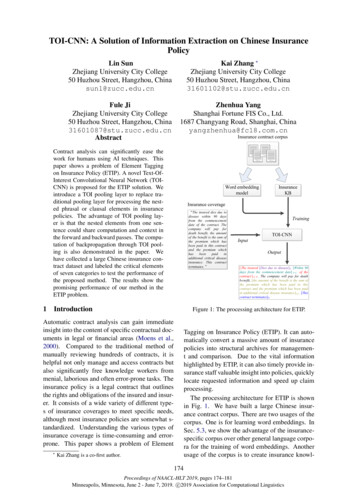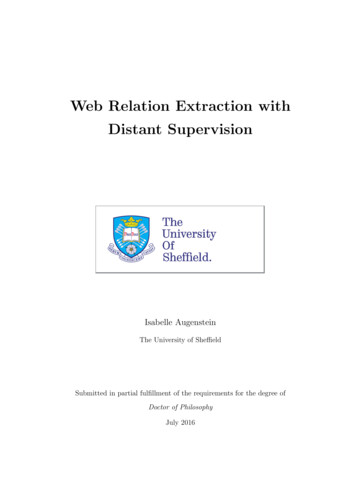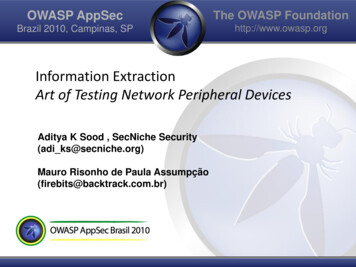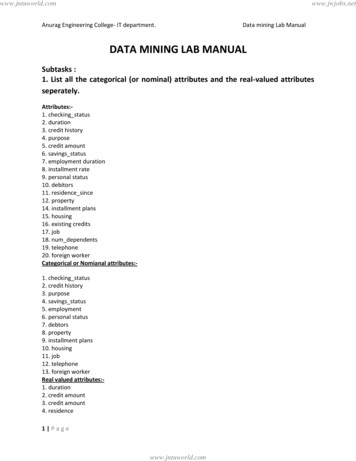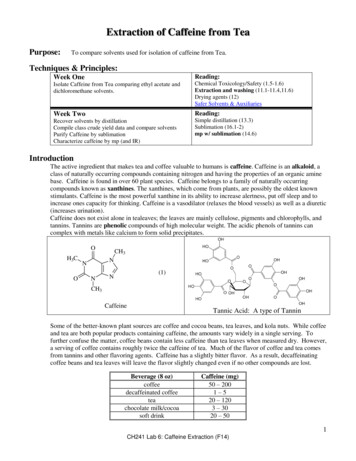
Transcription
Extraction of Caffeine from TeaPurpose:To compare solvents used for isolation of caffeine from Tea.Techniques & Principles:Week OneReading:Isolate Caffeine from Tea comparing ethyl acetate anddichloromethane solvents.Chemical Toxicology/Safety (1.5-1.6)Extraction and washing (11.1-11.4,11.6)Drying agents (12)Safer Solvents & AuxiliariesWeek TwoReading:Recover solvents by distillationCompile class crude yield data and compare solventsPurify Caffeine by sublimationCharacterize caffeine by mp (and IR)Simple distillation (13.3)Sublimation (16.1-2)mp w/ sublimation (14.6)IntroductionThe active ingredient that makes tea and coffee valuable to humans is caffeine. Caffeine is an alkaloid, aclass of naturally occurring compounds containing nitrogen and having the properties of an organic aminebase. Caffeine is found in over 60 plant species. Caffeine belongs to a family of naturally occurringcompounds known as xanthines. The xanthines, which come from plants, are possibly the oldest knownstimulants. Caffeine is the most powerful xanthine in its ability to increase alertness, put off sleep and toincrease ones capacity for thinking. Caffeine is a vasodilator (relaxes the blood vessels) as well as a diuretic(increases urination).Caffeine does not exist alone in tealeaves; the leaves are mainly cellulose, pigments and chlorophylls, andtannins. Tannins are phenolic compounds of high molecular weight. The acidic phenols of tannins cancomplex with metals like calcium to form solid precipitates.OH3COCH3NNN(1)NCH3CaffeineTannic Acid: A type of TanninSome of the better-known plant sources are coffee and cocoa beans, tea leaves, and kola nuts. While coffeeand tea are both popular products containing caffeine, the amounts vary widely in a single serving. Tofurther confuse the matter, coffee beans contain less caffeine than tea leaves when measured dry. However,a serving of coffee contains roughly twice the caffeine of tea. Much of the flavor of coffee and tea comesfrom tannins and other flavoring agents. Caffeine has a slightly bitter flavor. As a result, decaffeinatingcoffee beans and tea leaves will leave the flavor slightly changed even if no other compounds are lost.Beverage (8 oz)coffeedecaffeinated coffeeteachocolate milk/cocoasoft drinkCaffeine (mg)50 – 2001–520 – 1203 – 3020 – 501CH241 Lab 6: Caffeine Extraction (F14)
Several health concerns have been raised over the consumption of caffeine. The Food and DrugAdministration (FDA) has extensively studied the consumption of caffeine and its health effects. In 1987the FDA concluded that normal caffeine consumption does not increase risk to health. These studiesincluded cancer risk, coronary heart disease, osteoporosis, reproductive function, birth defects, andbehavior of children.Many consumers prefer to avoid caffeine partially or altogether due to its stimulant effects and others stillhave health concerns. This makes decaffeination of coffee and tea an important industrial process.Decaffeination is also significant for the world’s economy; approximately eight billion pounds of coffee aregrown a year making it second only to oil as an international commodity. It should be noted thatdecaffeinated coffee and tea are not caffeine free. These products can be labeled decaffeinated as long as97% of the caffeine has been removed.Greening the ChemistryThe industrial decaffeination process has evolved over the years. Initially direct contact methods usedchloroform (CHCl3), and more recently methylene chloride (CH2Cl2), as the solvent to repeatedly rinse thegreen (unroasted) coffee beans that had been softened by steam. Once sufficient caffeine had beenremoved, the beans would be roasted. Since these organic solvents have a high vapor pressure and lowboiling point, any solvent remaining in the beans is removed during roasting. This method has severalbrown characteristics. Both of these solvents are carcinogenic and have several human health concernswith methylene chloride having the lesser overall hazard. Chlorinated hydrocarbon waste has significantenvironmental impacts and is costly to dispose. Roasting also does not guarantee full removal of thesolvent, although solvent levels are rarely detectable. So why were these solvents used in the first place?Their advantages are that they are not water-soluble, have a low boiling point, and remove caffeine withoutremoving significant amounts of other compounds, leaving the majority of the flavor unaltered.Recently the direct contact process has been greened significantly using supercritical CO2. The greencoffee beans are steam softened with water and then supercritical CO2 is used to extract the caffeine. Oncethe system is returned to room temperature and pressure the coffee beans and separated caffeine are nowsolvent free as CO2 returns to the gas phase. Then the CO2 can be captured and reused. This method hasall the advantages of the above technique without the environmental and human health risks.Indirect contact methods have also been developed to decaffeinate coffee. The green coffee beans aresoaked (steeped) in almost boiling water until the caffeine is removed from the bean. The coffee solution isthen treated with ethyl acetate (a natural ester) which has moderate human health hazards but is notcarcinogenic. Ethyl acetate solvates caffeine more effectively than water and extracts the caffeine. Theremaining ethyl acetate is removed from the coffee solution by steaming. The coffee solution is thencombined with the beans which reabsorb the coffee oils as they are dried.The procedure we will be using with this experiment is also an indirect method for extractingcaffeine from coffee. We will be comparing the efficiency and “greenness” of ethyl acetate anddichloromethane as extraction solvents. We will also be separating the solvent from our crudeproduct by distillation. The distilled solvent will be collected and stored for reuse next year.Theory/DiscussionCaffeine (C8H10N4O2) is an alkaloid. Alkaloids are bitter tasting, natural nitrogen-containing compoundsfound in plants. Alkaloids are often found to have potent physiological activity. Some better knownexamples are morphine, heroin, lysergic acid (LSD), cocaine, quinine, strychnine, and nicotine.2CH241 Lab 6: Caffeine Extraction (F14)
The basic property of alkaloids come from the lone pair of electrons found on at least one nitrogen. Thebasic N in caffeine can be used to increase or decrease its water solubility. Acidic conditions will form theconjugate acid salt giving caffeine increased water solubility as a cation. On the other hand if caffeine is ina basic environment it takes the neutral form and is only somewhat polar.OH3COCH3NNAcidH3ONNOH3COOHBaseCH3More soluble in Nonpolar SolventsCH3NNNCH3NHMore soluble in waterIn order to successfully extract any substance from one solvent into another, we must maximize differencesin solubility. In some situations choosing a green process means trading some efficiency for human andenvironmental health. While 1-propanol or ethyl acetate may be a less efficient extractor than CHCl3 andCH2Cl2, we can maximize our efficiency by using a few simple techniques.1. Adding NaCl to the caffeine in water solution:a. The water will be more attracted to the very polar NaCl and less attracted to caffeine thus“salting out” the caffeine from water solution.2. Adding Ca(OH)2 or CaCO3 to a caffeine in water solution:a. This makes the solution basic so puts caffeine in its least polar form and so more readilysolvated in organic solvents and less attracted to water.b. The water solution contains much more than just caffeine, and some of these compoundsare also soluble in organic solvents. Basic Ca(OH)2 reacts with tannic acids to forminsoluble tannin salts which precipitate and so can be removed from the solution before thecaffeine is extracted.The organic extract will primarily contain caffeine with small amounts of impurities. This solutionis washed with 10% NaOH to remove impurities. Caffeine is also water soluble, but by keepingthe washing solution basic it minimizes the caffeine lost, while maximizing the removal ofimpurities.The extraction is analyzed by determining the partition coefficient (KP) (also known as the partitionconstant, partition ratio, distribution coefficient (Kd) or distribution ratio)KP solubilityin extractantsolubilityin source solution(3)where solubility is usually given in g/mL. Partition functions with larger values result in more efficientextractions.Extractions are most effective when repeated several times with small volumes of solvent rather than oncewith a large volume.3CH241 Lab 6: Caffeine Extraction (F14)
Procedures:Notes:Part 1:Extraction of CaffeineThe washings should berepeated a total of three times.The final washing may need tobe filtered to recover all theextract.1. Heat about 200.0 mL of distilled water to boiling.2. Weigh about 10-12 grams (about 5 bags) of tea leaves into a largebeaker. Record the actual mass used.3. Pour 100 mLs of the boiling water over the tea leaves. Cover with awatch glass and allow the solution to steep for 7-10 minutes.4. Pour the tea solution through cheesecloth into another beaker andpress out as much of the water in the tea leaves as possible. Set theextracted solution aside.5. Put the leaves from the cheesecloth back into the beaker and repeatthe tea extraction twice more with 25 mL of boiling water, lettingstand for five minutes, pouring through the cheese cloth and pressingout as much water as possible each time. Combine each of thewashings with the initially extracted solution.112To “salt out” the caffeinesince water will be moreattracted to the NaCl than it willbe to the caffeine making theamount of caffeine in the waterless.3The Ca(OH)2 will react withthe tannins in the tea toprecipitate them as Calciumsalts. Sometimes CalciumCarbonate is used. Calciumhydroxide also makes thesolution basic.46. To the combined extracts add approximately 20 g of sodium chloride2 and about 1 gram total of calcium hydroxide. 37. Heat and stir the solution for 15 minutes (near boiling).48. Vacuum filter the hot solution through a Buchner funnel to removeany undissolved solids. Cool the solution to room temperature.9. Pour the tea extract into a separatory funnel supported in an iron ringand extract5 with 4 successive 25 mL portions of extraction solvent(1-propanol, dichloromethane or ethyl acetate). 610. Combine the organic extracts in a separatory funnel and wash oncewith 25 mL of 10% aqueous NaOH solution.11. Transfer the extract solution into an Erlenmeyer flask and dry byadding about 2-3 grams of anhydrous magnesium sulfate or sodiumsulfate and swirling occasionally until it no longer clumps.This process will enable thesalt to dissolve and more of thetannins to precipitate.5Mix the solutions gently tominimize emulsion formationand vent the separatory funnelfrequently, especially duringinitial mixing to avoid pressurebuildup. Make sure anyemulsion layer has mostlydisappeared before separating.61-propanol or ethyl acetate willbe top layers; dichloromethanewill form a bottom layer. If alayer is not clearly visible, addan additional portion (10-25mLs) of solvent to theseparatory funnel. Stir gentlywith a stirring rod to break upany emulsion.12. Decant (or filter) the dried extract into a 250 mL round bottom flask(RBF) and add a few boiling chips to be ready for distillation.13. Continue on to Part 2 or this is an appropriate stopping place if youare out of time. Stopper your RBF and place on a cork support inyour laboratory drawer for next week.4CH241 Lab 6: Caffeine Extraction (F14)
Part 2: Purification of Caffeine7The boiling point of1-Propanol is 97-98oCEthyl acetate is 77.1oCDichloromethane is 39.6oC14. Prepare a simple distillation apparatus.15. Distill the extraction solvent (either 1-propanol,ethyl acetate, or dichloromethane) from thecaffeine extract using a water bath as a heatsource. Carefully monitor the temperature so asnot to overheat the caffeine and so that only theextraction solvent is distilled. 78Stop the distillation (remove from the hot water bath)before the flask is dry when either the vapor temperaturedrops and no more distillate is being collected in thereceiving flask or when the temperature exceeds theboiling point of the solvent by more than 5 C.916. Stop the distillation (remove the heat source) justbefore the flask is dry. 817. Take your distilled solvent and measure thevolume (accurate to 1 mL), and add it to thecorresponding recycled solvent collectioncontainer. 9The recovered solvents will be used next year for thisexperiment.10Crude caffeine should be a light tan color and onlyturns dark brown when degraded due to high heat.11. Alternately the crude caffeine could be put into a preweighed filter flask to be ready for sublimation underreduced pressure (vacuum)Vacuum Sublimation apparatus:18. Rinse the crude caffeine10 residue in the flaskwith a couple small portions of acetone into apre-weighed (tared) glass Petri dish11 andevaporate the acetone using a low heat or astream of air.19. Determine the mass of the crude caffeine.20. Purify your caffeine by sublimation atatmospheric pressure12, carefully monitoring theheat so as to minimize the decomposition of yourcaffeine.12Atmospheric Sublimation apparatus21. Determine the mass of the pure product and themelting point. 1322. Use the FT-IR to identify your product ascaffeine.Caffeine13Caffeine will sublime during melting so the meltingpoint must be taken in a sealed tube.Written Report:For this experiment create a formal report following the formal report guidelines given. Besides the overall process the report should include a specific evaluation of greenness including comparison ofsolvents used. When determining Percent yield of caffeine from original sample assume that the maximum mg of caffeine is insolution before extraction. (Note that 1 oz 29.57 mL)References:Murray, D.S.; Hansen, P.J., J. Chem. Educ., 1995 (72) 851.Ham
CH241 Lab 6: Caffeine Extraction (F14) Procedures: Part 1:Extraction of Caffeine 1. Heat about 200.0 mL of distilled water to boiling. 2. Weigh about 10-12 grams (about 5 bags) of tea leaves into a large beaker. Record the actual mass used. 3. Pour 100 mLs of the boiling water over the tea leaves.
